Äîêóìåíòàöèÿ è îïèñàíèÿ www.docs.chipfind.ru
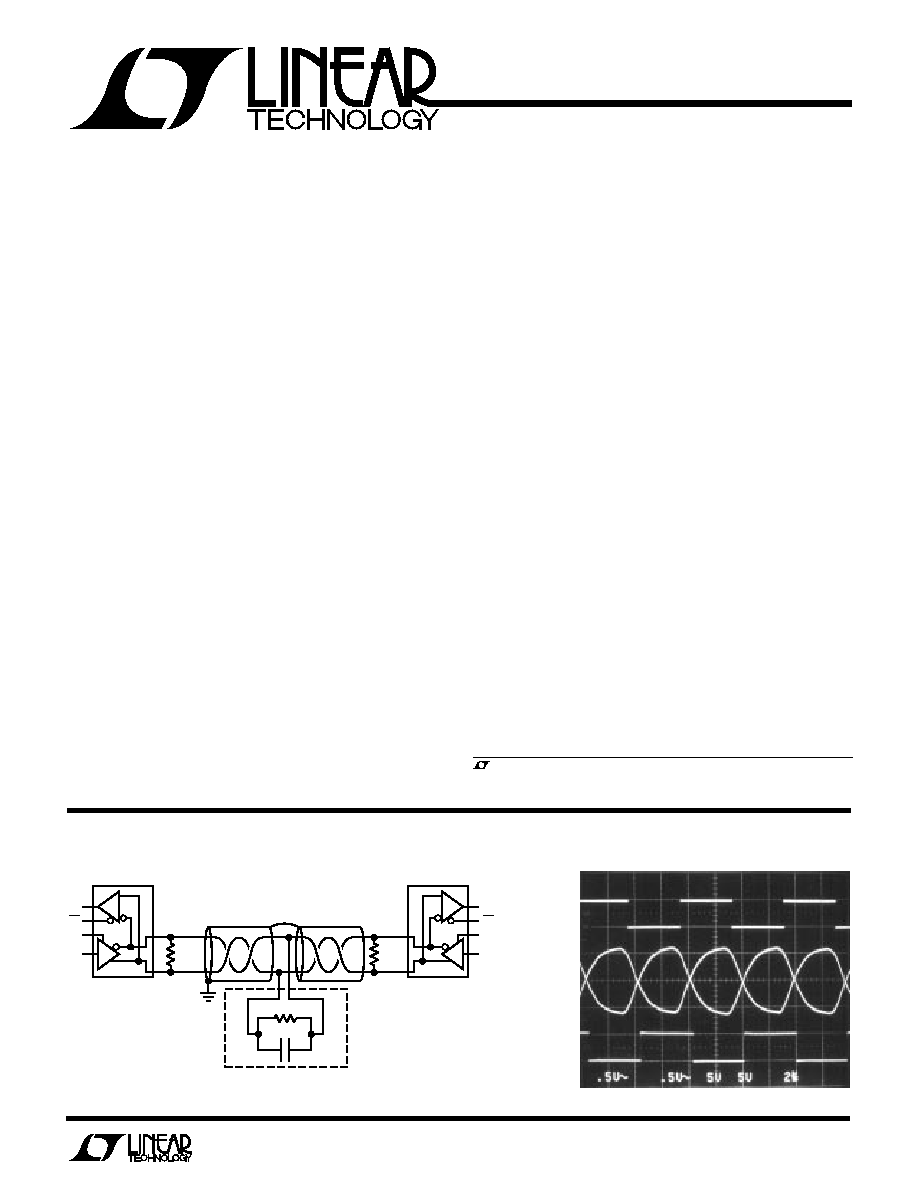
1
LTC1487
Ultra-Low Power RS485
with Low EMI, Shutdown
and High Input Impedance
S
FEATURE
D
U
ESCRIPTIO
The LTC
®
1487 is an ultra-low power differential line trans-
ceiver designed with high impedance inputs allowing up to
256 transceivers to share a single bus. It meets the
requirements of RS485 and RS422. The LTC1487 features
output drivers with controlled slew rate, decreasing the
EMI radiated from the RS485 lines, and improving signal
fidelity with misterminated lines. The CMOS design offers
significant power savings without sacrificing ruggedness
against overload or ESD damage. Typical quiescent cur-
rent is only 80
µ
A while operating and 1
µ
A in shutdown.
The driver and receiver feature three-state outputs, with
the driver outputs maintaining high impedance over the
entire common-mode range. Excessive power dissipation
caused by bus contention or faults is prevented by a
thermal shutdown circuit which forces the driver outputs
into a high impedance state. The receiver has a fail-safe
feature which guarantees a high output state when the
inputs are left open. I/O pins are protected against multiple
ESD strikes of over
±
10kV using the Human Body Model.
The LTC1487 is fully specified over the commercial tem-
perature range and is available in 8-pin DIP and SO
packages.
s
High Input Impedance: Up to 256 Transceivers
on the Bus
s
Low Power: I
CC
= 120
µ
A Max with Driver Disabled
s
I
CC
= 200
µ
A Max with Driver Enabled, No Load
s
1
µ
A Quiescent Current in Shutdown Mode
s
Controlled Slew Rate Driver for Reduced EMI
s
Single 5V Supply
s
ESD Protection to
±
10kV On Receiver Inputs and
Driver outputs
s
7V to 12V Common-Mode Range Permits
±
7V
Ground Difference Between Devices on the Data Line
s
Thermal Shutdown Protection
s
Power Up/Down Glitch-Free Driver Outputs Permit
Live Insertion or Removal of Transceiver
s
Driver Maintains High Impedance in Three-State
or with the Power Off
s
Pin Compatible with the LTC485
U
A
O
PPLICATI
TYPICAL
s
Battery-Powered RS485/RS422 Applications
s
Low Power RS485/RS422 Transceiver
s
Level Translator
U
S
A
O
PPLICATI
R
1
RO
120
RE
DE
DI
2
3
7
6
7
6
4
1
2
3
4
D
R
D
RO
RE
DE
DI
LTC1487 · TA01
120
330
LTC1487
LTC1487
EQUIVALENT LOAD OF 256
LTC1487 TRANSCEIVERS
2000 FEET OF TWISTED-PAIR WIRE
4.7nF
DI
A
B
RO
RECEIVER INPUT
LTC1487 · TA02
, LTC and LT are registered trademarks of Linear Technology Corporation.
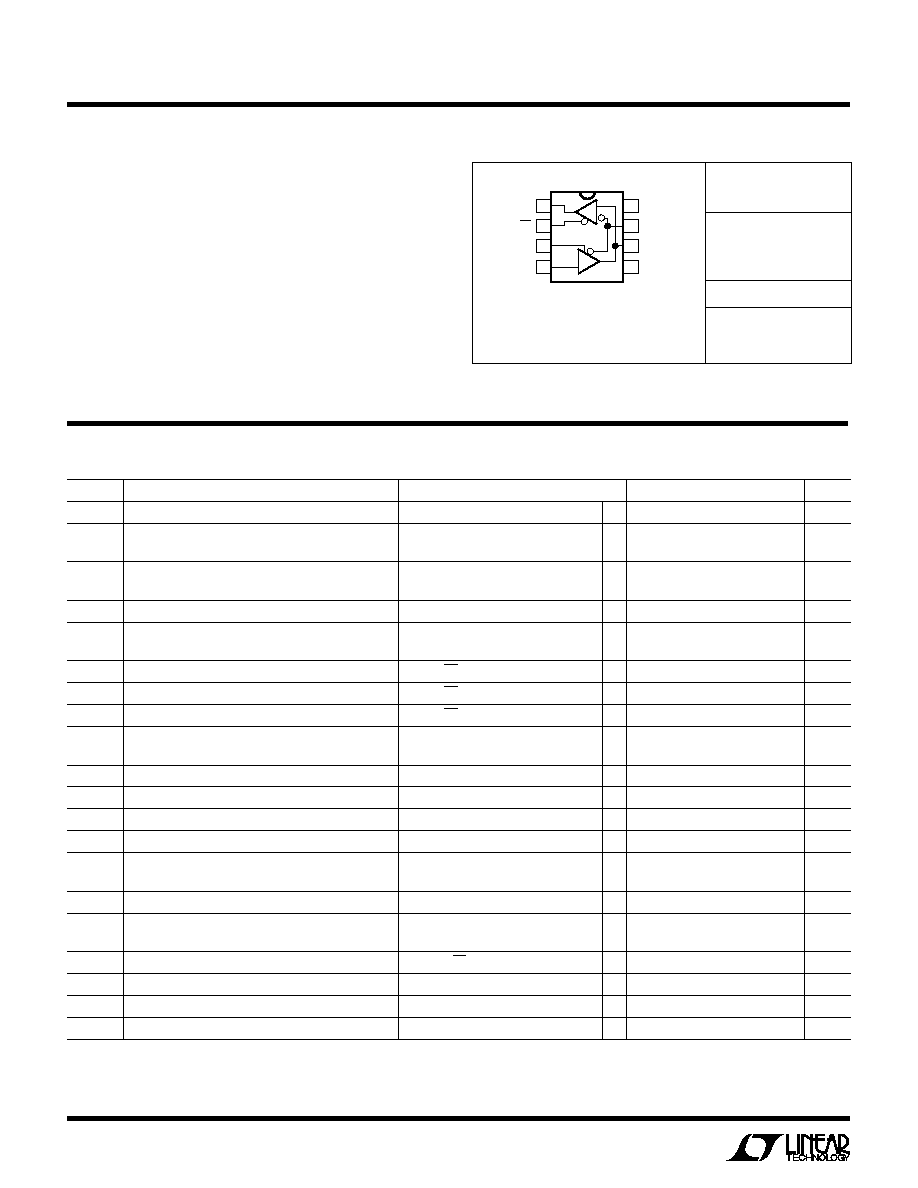
2
LTC1487
A
U
G
W
A
W
U
W
A
R
BSOLUTE
XI
TI
S
W
U
U
PACKAGE/ORDER I FOR ATIO
(Note 1)
Supply Voltage (V
CC
) .............................................. 12V
Control Input Voltage ..................... 0.5V to V
CC
+ 0.5V
Driver Input Voltage ....................... 0.5V to V
CC
+ 0.5V
Driver Output Voltage ...........................................
±
14V
Receiver Input Voltage ..........................................
±
14V
Receiver Output Voltage ................ 0.5V to V
CC
+ 0.5V
Operating Temperature Range ............. 0
°
C
T
A
70
°
C
Lead Temperature (Soldering, 10 sec) ................. 300
°
C
ORDER PART
NUMBER
LTC1487CN8
LTC1487CS8
S8 PART MARKING
1487
T
JMAX
= 125
°
C,
JA
= 130
°
C/ W (N8)
T
JMAX
= 125
°
C,
JA
= 150
°
C/ W (S8)
1
2
3
4
8
7
6
5
TOP VIEW
V
CC
B
A
GND
N8 PACKAGE
8-LEAD PDIP
S8 PACKAGE
8-LEAD PLASTIC SO
R
D
RO
RE
DE
DI
Consult factory for Industrial and Military grade parts.
ELECTRICAL C
C
HARA TERISTICS
0
°
C
T
A
70
°
C, V
CC
= 5V (Notes 2, 3) unless otherwise noted.
SYMBOL
PARAMETER
CONDITIONS
MIN
TYP
MAX
UNITS
V
OD1
Differential Driver Output Voltage (Unloaded)
I
O
= 0
q
5
V
V
OD2
Differential Driver Output Voltage (with Load)
R = 50
(RS422)
q
2.0
V
R = 27
(RS485), Figure 1
q
1.5
5
V
V
OD
Change in Magnitude of Driver Differential Output
R = 27
or R = 50
, Figure 1
q
0.2
V
Voltage for Complementary Output States
V
OC
Driver Common-Mode Output Voltage
R = 27
or R = 50
, Figure 1
q
3
V
V
OC
Change in Magnitude of Driver Common-Mode
R = 27
or R = 50
, Figure 1
q
0.2
V
Output Voltage for Complementary Output States
V
IH
Input High Voltage
DE, DI, RE
q
2
V
V
IL
Input Low Voltage
DE, DI, RE
q
0.8
V
I
IN1
Input Current
DE, DI, RE
q
±
2
µ
A
I
IN2
Input Current (A, B)
DE = 0, V
CC
= 0V or 5.25V, V
IN
= 12V
q
0.30
mA
DE = 0, V
CC
= 0V or 5.25V, V
IN
= 7V
q
0.15
mA
V
TH
Differential Input Threshold Voltage for Receiver
7V
V
CM
12V
q
0.2
0.2
V
V
TH
Receiver Input Hysteresis
V
CM
= 0V
q
45
mV
V
OH
Receiver Output High Voltage
I
O
= 4mA, V
ID
= 200mV
q
3.5
V
V
OL
Receiver Output Low Voltage
I
O
= 4mA, V
ID
= 200mV
q
0.4
V
I
OZR
Three-State (High Impedance) Output
V
CC
= Max, 0.4V
V
O
2.4V
q
±
1
µ
A
Current at Receiver
R
IN
Receiver Input Resistance
7V
V
CM
12V
q
70
96
k
I
CC
Supply Current
No Load, Output Enabled
q
120
200
µ
A
No Load, Output Disabled
q
80
120
µ
A
I
SHDN
Supply Current in Shutdown Mode
DE = 0V, RE = V
CC
1
10
µ
A
I
OSD1
Driver Short-Circuit Current, V
OUT
= HIGH
7V
V
O
12V
q
35
250
mA
I
OSD2
Driver Short-Circuit Current, V
OUT
= LOW
7V
V
O
12V
q
35
250
mA
I
OSR
Receiver Short-Circuit Current
0V
V
O
V
CC
q
7
85
mA
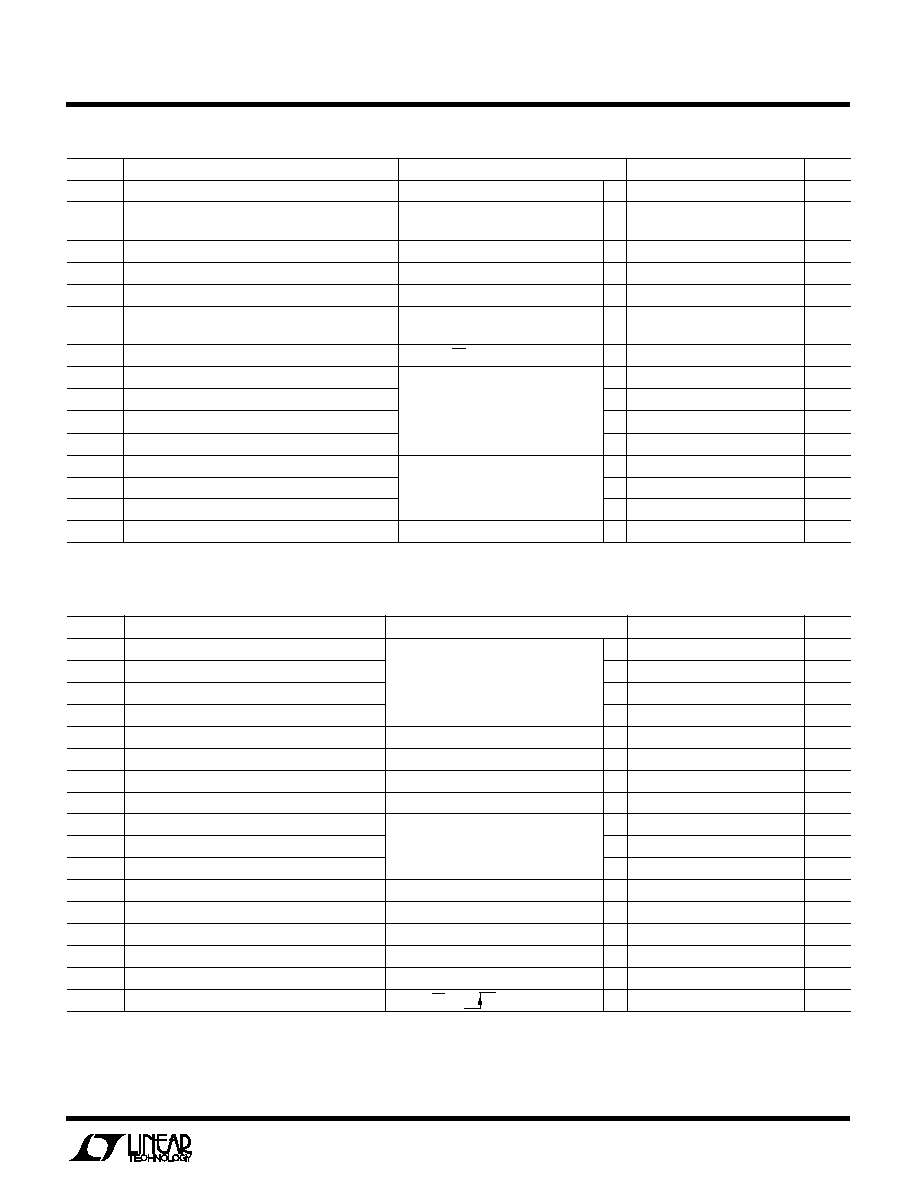
3
LTC1487
ELECTRICAL C
C
HARA TERISTICS
40
°
C
T
A
85
°
C, V
CC
= 5V (Note 4) unless otherwise noted.
SYMBOL
PARAMETER
CONDITIONS
MIN
TYP
MAX
UNITS
V
OD1
Differential Driver Output Voltage (Unloaded)
I
O
= 0
q
5
V
V
OD2
Differential Driver Output Voltage (with Load)
R = 50
(RS422)
q
2.0
V
R = 27
(RS485), Figure 1
q
1.5
5
V
V
OC
Driver Common-Mode Output Voltage
R = 27
or R = 50
, Figure 1
q
3
V
V
TH
Differential Input Threshold Voltage for Receiver
7V
V
CM
12V
q
0.2
0.2
V
V
TH
Receiver Input Hysteresis
V
CM
= 0V
q
45
mV
I
CC
Supply Current
No Load, Output Enabled
q
120
200
µ
A
No Load, Output Disabled
q
80
120
µ
A
I
SHDN
Supply Current in Shutdown Mode
DE = 0V, RE = V
CC
1
10
µ
A
t
PLH
Driver Input to Output
R
DIFF
= 54
, C
L1
= C
L2
= 100pF,
q
150
1200
ns
t
PHL
Driver Input to Output
q
150
1200
ns
t
SKEW
Driver Output to Output
q
100
600
ns
t
r
, t
f
Driver Rise or Fall Time
q
150
2000
ns
t
PLH
Receiver Input to Output
R
DIFF
= 54
, C
L1
= C
L2
= 100pF,
q
30
140
250
ns
t
PHL
Receiver Input to Output
q
30
140
250
ns
t
SKD
t
PLH
t
PHL
Differential Receiver Skew
q
13
ns
f
MAX
Maximum Data Rate
q
250
kbps
(Figures 3, 5)
(Figures 3, 7)
SYMBOL
PARAMETER
CONDITIONS
MIN
TYP
MAX
UNITS
t
PLH
Driver Input to Output
R
DIFF
= 54
, C
L1
= C
L2
= 100pF,
q
150
1200
ns
t
PHL
Driver Input to Output
q
150
1200
ns
t
SKEW
Driver Output to Output
q
250
600
ns
t
r
, t
f
Driver Rise or Fall Time
q
150
1200
ns
t
ZH
Driver Enable to Output High
C
L
= 100pF (Figures 4, 6), S2 Closed
q
100
1500
ns
t
ZL
Driver Enable to Output Low
C
L
= 100pF (Figures 4, 6), S1 Closed
q
100
1500
ns
t
LZ
Driver Disable Time from Low
C
L
= 15pF (Figures 4, 6), S1 Closed
q
150
1500
ns
t
HZ
Driver Disable Time from High
C
L
= 15pF (Figures 4, 6), S2 Closed
q
150
1500
ns
t
PLH
Receiver Input to Output
R
DIFF
= 54
, C
L1
= C
L2
= 100pF,
q
30
140
250
ns
t
PHL
Receiver Input to Output
q
30
140
250
ns
t
SKD
t
PLH
t
PHL
Differential Receiver Skew
q
13
ns
t
ZL
Receiver Enable to Output Low
C
RL
= 15pF (Figures 2, 8), S1 Closed
q
20
50
ns
t
ZH
Receiver Enable to Output High
C
RL
= 15pF (Figures 2, 8), S2 Closed
q
20
50
ns
t
LZ
Receiver Disable from Low
C
RL
= 15pF (Figures 2, 8), S1 Closed
q
20
50
ns
t
HZ
Receiver Disable from High
C
RL
= 15pF (Figures 2, 8), S2 Closed
q
20
50
ns
f
MAX
Maximum Data Rate
q
250
kbps
t
SHDN
Time to Shutdown
DE = 0, RE =
q
50
200
600
ns
0
°
C
T
A
70
°
C, V
CC
= 5V (Notes 2, 3) unless otherwise noted.
SWITCHI G CHARACTERISTICS
U
(Figures 3, 5)
(Figures 3, 7)
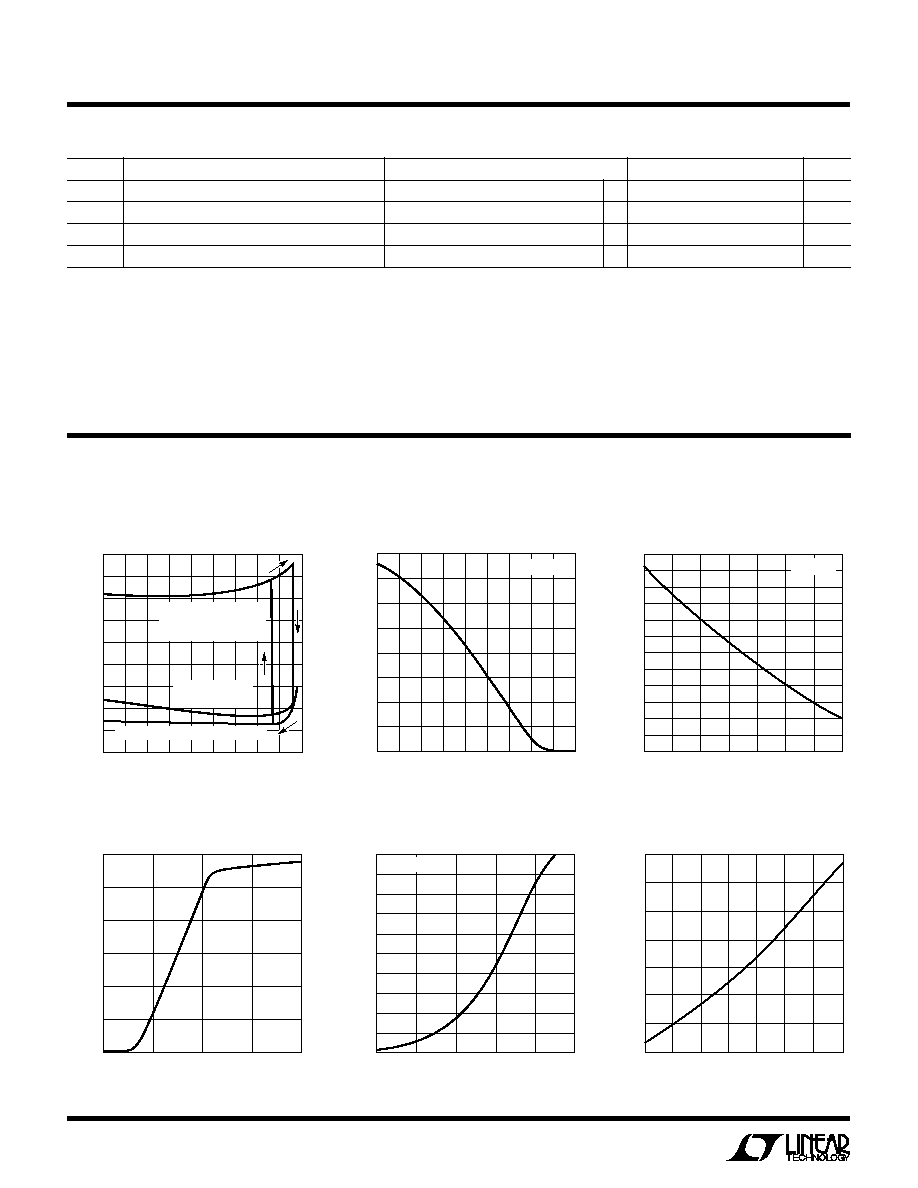
4
LTC1487
0
°
C
TA
70
°
C, V
CC
= 5V (Notes 2, 3) unless otherwise noted.
SWITCHI G CHARACTERISTICS
U
SYMBOL
PARAMETER
CONDITIONS
MIN
TYP
MAX
UNITS
t
ZH(SHDN)
Driver Enable from Shutdown to Output High
C
L
= 100pF (Figures 4, 6), S2 Closed
q
2000
ns
t
ZL(SHDN)
Driver Enable from Shutdown to Output Low
C
L
= 100pF (Figures 4, 6), S1 Closed
q
2000
ns
t
ZH(SHDN)
Receiver Enable from Shutdown to Output High
C
L
= 15pF (Figures 2, 8), S2 Closed
q
2000
ns
t
ZL(SHDN)
Receiver Enable from Shutdown to Output Low
C
L
= 15pF (Figures 2, 8), S1 Closed
q
2000
ns
Note 3: All typicals are given for V
CC
= 5V and T
A
= 25
°
C.
Note 4: The LTC1487 is not tested and is not quality-assurance sampled at
40
°
C and at 85
°
C. These specifications are guaranteed by design,
correlation, and/or inference from 0
°
C, 25
°
C and/or 70
°
C tests.
The
q
denotes specifications which apply over the full operating
temperature range.
Note 1: Absolute maximum ratings are those beyond which the safety of
the device cannot be guaranteed.
Note 2: All currents into device pins are positive; all currents out ot device
pins are negative. All voltages are referenced to device ground unless
otherwise specified.
TYPICAL PERFOR
M
A
N
CE CHARACTERISTICS
U
W
TEMPERATURE (
°
C)
50
0
SUPPLY CURRENT (
µ
A)
50
150
200
250
100
450
LTC1487 · TPC01
100
25
175
50
25
125
75
0
150
300
350
400
DRIVER ENABLED
WITH NO LOAD
THERMAL SHUTDOWN
WITH DRIVER ENABLED
AND NOMINAL LOAD
DRIVER DISABLED WITH NO LOAD
Supply Current vs Temperature
Driver Differential Output Voltage
vs Output Current
Driver Output Low Voltage
vs Output Current
OUTPUT VOLTAGE (V)
0
0
OUTPUT CURRENT (mA)
20
40
60
80
100
120
T
A
= 25
°
C
1
2
3
4
LTC1487 · TPC04
TEMPERATURE (
°
C)
50
350
400
500
25
75
LT
C1487 · G06
300
250
25
0
50
100
125
200
150
450
TIME (ns)
Driver Skew vs Temperature
OUTPUT VOLTAGE (V)
0
OUTPUT CURRENT (mA)
40
50
60
4.0
LTC1487 · TPC02
30
20
0
1.0
2.0
3.0
0.5
4.5
1.5
2.5
3.5
10
80
70
T
A
= 25
°
C
Driver Output High Voltage
vs Output Current
OUTPUT VOLTAGE (V)
0
OUTPUT CURRENT (mA)
40
20
0
4
LTC1487 · TPC05
60
80
50
30
10
70
90
100
1
2
3
5
T
A
= 25
°
C
Driver Differential Output Voltage
vs Temperature
TEMPERATURE (
°
C)
50
DIFFERENTIAL VOLTAGE (V)
2.08
2.20
2.22
2.24
0
50
75
LTC1487 · TPC03
2.04
2.02
2.16
2.12
2.06
2.18
2.00
2.14
2.10
25
25
100
125
R
L
= 54
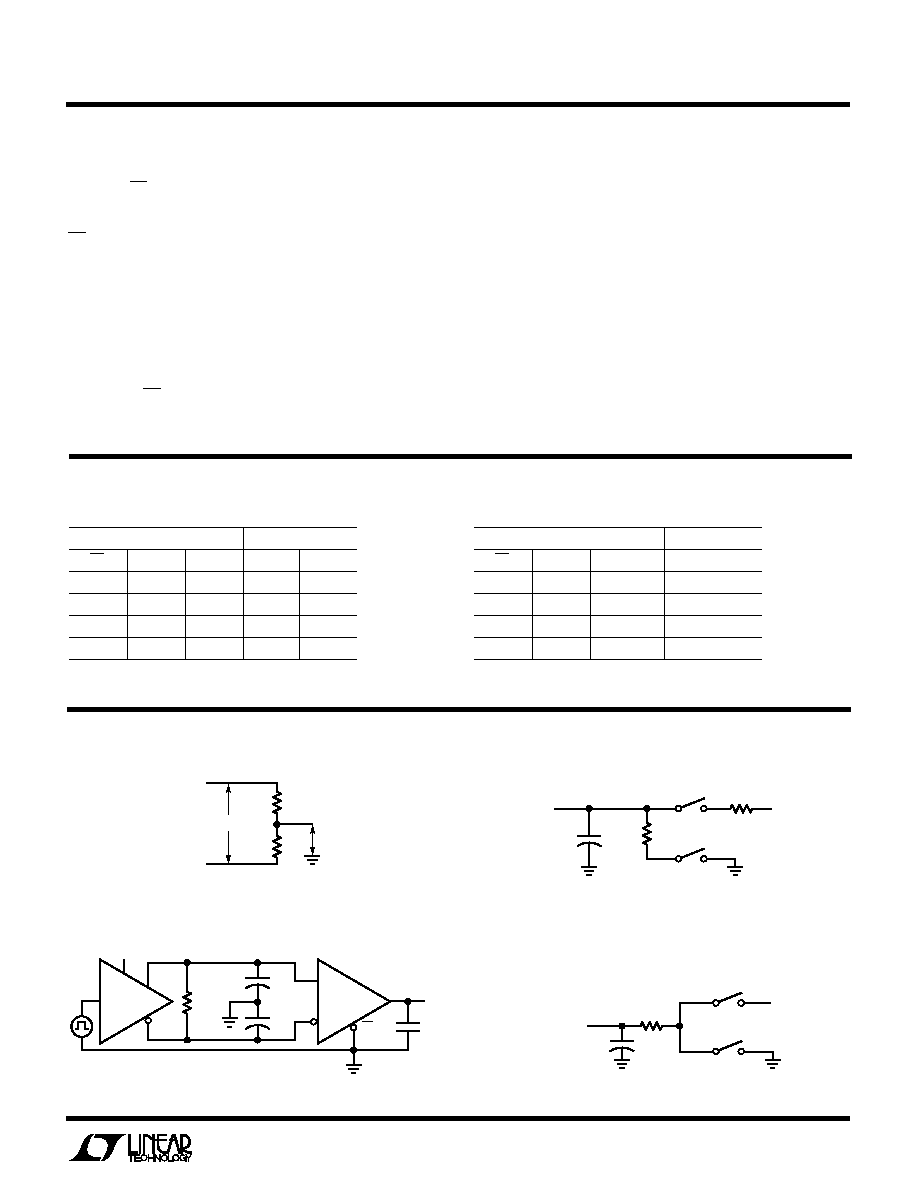
5
LTC1487
DI (Pin 4): Driver Input. If the driver outputs are enabled
(DE HIGH) then a LOW on DI forces the outputs A LOW and
B HIGH. A HIGH on DI with the driver outputs enabled will
force A HIGH and B LOW.
GND (Pin 5): Ground.
A (Pin 6): Driver Output/Receiver Input.
B (Pin 7): Driver Output/Receiver Input.
V
CC
(Pin 8): Positive Supply. 4.75V < V
CC
< 5.25V.
PI
N
FU
N
CTIO
N
S
U
U
U
RO (Pin 1): Receiver Output. If the receiver output is
enabled (RE LOW), and A > B by 200mV, RO will be HIGH.
If A < B by 200mV, then RO will be LOW.
RE (Pin 2): Receiver Output Enable. A LOW enables the
receiver output, RO. A HIGH input forces the receiver
output into a high impedance state.
DE (Pin 3): Driver Outputs Enable. A HIGH on DE enables
the driver output. A and B and the chip will function as a line
driver. A LOW input will force the driver outputs into a high
impedance state and the chip will function as a line
receiver. If RE is HIGH and DE is LOW, the part will enter
a low power (1
µ
A) shutdown state.
Figure 3. Driver/Receiver Timing Test Circuit
Figure 4. Driver Timing Test Load
OUTPUT
UNDER TEST
C
L
S1
S2
V
CC
500
LTC1487 · F04
3V
DE
A
B
DI
R
DIFF
C
L1
C
L2
RO
15pF
A
B
RE
LTC1487 · F03
Figure 1. Driver DC Test Load
Figure 2. Receiver Timing Test Load
V
OD
A
B
R
R
V
OC
LTC1487 · F01
RECEIVER
OUTPUT
C
RL
1k
S1
S2
TEST POINT
V
CC
1k
LTC1487 · F02
TEST CIRCUITS
LTC1487 Transmitting
INPUTS
OUTPUTS
RE
DE
DI
B
A
X
1
1
0
1
X
1
0
1
0
0
0
X
Z
Z
1
0
X
Z*
Z*
*Shutdown mode
LTC1487 Receiving
INPUTS
OUTPUTS
RE
DE
A B
RO
0
0
0.2V
1
0
0
0.2V
0
0
0
Inputs Open
1
1
0
X
Z*
*Shutdown mode
FU CTIO TABLES
U
U




